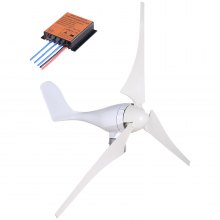Power The Future with VEVOR Wind Turbines: Unleash Renewable Energy
Wind turbines, which tower tall and majestically while utilizing the untamed power of the wind, have emerged as a beacon of hope in the search for a sustainable future. A wind turbine represents an advancement in the search for sustainable energy because of its imposing appearance and gracefully slicing blades.
A wind turbine is fundamentally a mechanical marvel built to capture and transform wind kinetic energy into useful electrical power. VEVOR Wind Turbines is at the vanguard of this transformative journey, providing cutting-edge solutions to unlock the unrealized potential of renewable energy.
A Deeper Look into the Mechanics of Wind Turbines
Wind turbines are a symbol of our creativity and our dedication to using renewable, clean energy sources. The tower, nacelle, and rotor are the three fundamental parts of a standard wind turbine. The tower stands tall above the ground and offers a solid support framework for the entire system.
The complex machinery, including the generator and gearbox, that transforms the rotational energy of the blades into electricity, is housed in the nacelle, which is at the top of the tower. The rotor's two or three aerodynamically formed blades are the final component, and they are what start the rotation by absorbing wind energy.
An amazing series of actions occur during the conversion of wind energy into electrical power. The rotor's blades revolve due to the wind's impact on them. Like an airplane's wings, the blades' shape and angle were meticulously chosen to optimize lift. The main shaft inside the nacelle receives rotational energy from the spinning blades.
A gearbox inside the nacelle increases the rotating speed to the ideal amount for power production. The high-speed shaft then drives a generator, which employs electromagnetic induction to transform mechanical energy into electrical energy. Typically, this electricity is supplied to a power grid, which combines with other energy sources to meet the needs of homes, companies, and other facilities.
Various Types and Designs of Wind Turbines
Wind turbines exist in various sizes and designs; each specifically made to capture wind energy effectively. Breakthroughs develop as technology advances, influencing the direction of renewable energy. Below are the types of wind turbines:
● Horizontal Axis Wind Turbines: HAWTs, the most prevalent kind, feature blades positioned on a horizontal axis that resemble enormous pinwheels. Depending on how the rotor is positioned to the wind, they can be categorized as upwind or downwind turbines.
● Darrieus Wind Turbines: Darrieus turbines, a form of VAWT with curved blades, provide lift as the wind passes over the airfoil-shaped blades. They have a strong starting torque and perform well in strong gusts but need more assistance to remain steady.
● Offshore Wind Turbines: These wind turbines are often larger than their onshore counterparts because they are made to operate in offshore conditions. Offshore locations provide higher and more reliable wind speeds, enhancing the potential for energy production.
● Vertical Axis Wind Turbines: VAWTs, instead of HAWTs, feature blades oriented around a vertical axis resembling helixes or egg beaters. They are appropriate for urban or low-wind conditions and are frequently more compact.
● Hybrid Wind Turbines: For continuous electricity, these wind turbines combine two or more energy sources, such as solar and wind. Hybrid systems improve energy security and can store extra energy.
Exploring The Uses of Wind Turbines
With their compelling environmental presence, wind turbines serve many purposes besides producing electricity. Innovative uses show off the adaptability of wind power as technology develops. Below are some of the uses of wind turbines:
● Electricity generation
● Hybrid energy system
● Off-grid power
● Desalination
● Water pumping
● Wind-powered vehicles
Selecting the Right Wind Turbine Size and Type
Choosing the proper wind turbine type and size for optimum efficiency is crucial before starting the path of capturing wind energy. Here are some factors to consider when selecting the right wind turbine:
● Access your energy needs
● Understand turbine size
● Analyze wind resources
● Consider size limitations
● Type of wind turbine
Why Choose VEVOR Wind Turbines?
With VEVOR wind turbines, embrace a more enlightened and sustainable future. Our state-of-the-art technology guarantees top performance, maximizing the power of the wind. Our wind turbines dramatically lower your carbon footprint with an emphasis on sustainability, helping to create a greener planet.
You can rely on VEVOR for dependability; our robust turbines provide a reliable power supply with knowledgeable support throughout your journey. Our adaptable choices can be tailored to your needs and meet different regions' and energy demands. VEVOR wind turbines offer affordable costs without sacrificing quality, making them the wise choice for a greener future.
FAQs about Wind Turbine
Q: How big of a wind turbine do I need to power my house?
The wind turbine size required to power a house will vary from 1 kW to 10 kW depending on energy demand, wind resources, and efficiency.
Q: How much electricity can a home wind turbine generate?
Size, wind resources, and efficiency all affect how much electricity a residential wind turbine can produce. Small turbines can generate between 1,000 and 5,000 kWh annually.
Q: What wind speed is required for optimal turbine performance?
Generally speaking, a minimum average wind speed of 12 to 15 miles per hour is needed for optimal turbine operation. Although higher wind speeds up to 54 mph might enhance energy output, wind turbines have safety features to guard against excessive wind speeds.
Q: Can wind turbines work in low-wind areas?
Wind turbines can function in low-wind places, but they may perform less effectively and produce less power than in areas with stronger winds.
Q: Is there a backup power source in case of low wind or outages?
Yes, wind energy systems frequently use backup power sources like batteries or a grid connection to provide electricity during periods of low wind or power outages.



































































































